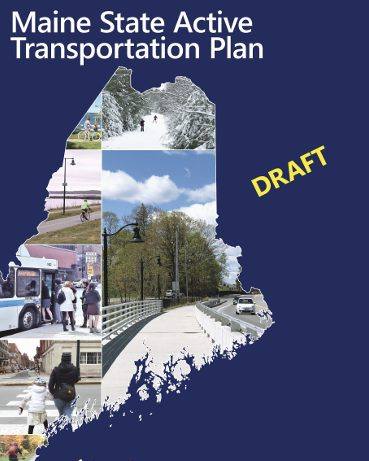Cars and trucks can get us to many places, but a system designed around personal vehicles comes with a host of problems. Cars are expensive to maintain, polluting, and dangerous, and the system of roads needed to support them is in constant need of repair, which puts a burden on local communities and taxpayers. We have an opportunity to fix that by providing people with a wider range of choices for how to get around.
Providing opportunities to drive less includes many benefits for our climate, health, economy, and equity. Better paths for biking or walking complemented by more accessible and reliable transit would allow Mainers to replace short car trips, engage with Maine’s beautiful outdoors, and lead healthier lifestyles.
Maine has long been dependent on cars and trucks for transportation. Ninety-three percent of Maine families own at least one vehicle, and eighty-nine percent of Mainers commute by car or truck on a day-to-day basis. On average, a typical Mainer drives 12,000 miles per year, or about 33 miles per day.1

By and large, Maine’s transportation planning and funding priorities have reflected our dependence on cars and trucks, but there are signs that this may be changing. Earlier this month, the Maine Department of Transportation (MDOT) released the newest iteration of the state’s Long Range Transportation Plan (LRTP) outlining the vision for Maine’s transportation system over the next 20+ years.
It includes Maine’s first-ever Statewide Active Transportation Plan, which articulates a need to improve our state’s biking and walking infrastructure to encourage active transportation for commuting, running errands, and connecting with community. It also includes an updated State Transit Plan that speaks to the need for more consistent and expanded transit options to meet the needs of all Mainers.
At the Natural Resources Council of Maine, we reviewed these plans, gave MDOT our suggestions to make them stronger, and will continue to track the implementation of these plans as key opportunities to build healthier, more connected communities.
Active transportation infrastructure is shown to support local economies.
We are encouraged to see the Department consider the Maine Active Transportation Arterials plan assembled by the Maine Trails Coalition, an exciting and achievable vision that would bring a multitude of health, climate, and economic benefits to Maine by connecting Maine’s 25 largest municipalities with active transportation trails. These trails can significantly boost local economies. For example, an economic study of the Eastern Trail in southern Maine highlights a total annual economic impact of $44.6 million.
More regular and accessible public transit would reduce vehicle congestion, support the mobility of low-income communities, and encourage transit-oriented development that would support local businesses.
For those families that cannot afford a car or who are unable to drive, a robust public transit network is vital to provide access to medical appointments, shopping centers, and other essential services. Maine’s population is the oldest in the nation and is continuing to age, emphasizing the need for better options that don’t require driving – like public transit — throughout the state.
A trend toward increased multimodal transportation funding and planning is encouraging, but we need to continue pushing for implementation of these new plans.
Prior to 2022, only eight percent of funding distributed by MDOT went to multimodal transportation (MDOT defined that as any transportation that is not personal vehicles, such as transit, aviation, ferries, biking, and walking). The passage of the federal Bipartisan Infrastructure Law brought an influx of new funding for diverse transportation solutions, and the 2022 MDOT work plan showed an increase to the multimodal allocation up to 20% of total funding. This year’s work plan shows an additional 1 percent boost, bringing the multimodal allocation up to 21 percent of total MDOT funding.
Both the Statewide Active Transportation Plan and the State Transit Plan call for increased and more regular funding to support car alternatives, but neither presents long-term, sustainable funding mechanisms or concrete implementation timelines that would allow for accountability over time.
Maine needs a modern transportation system that is less dependent on polluting fossil fuels and dangerous car infrastructure.
Building active transportation infrastructure and improving the state’s public transit system align directly with the aims of the Maine Climate Action Plan and the Maine Economic Development Strategy. We look forward to seeing the vision for Maine’s diverse transportation future actualized through committed and continued investment.
—by Josh Caldwell, NRCM Climate & Clean Energy Outreach Coordinator












Leave a Reply